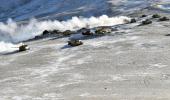The disengagement of armies of India and China from north and south banks of Pangong Tso is a "very good end result" and a win-win situation for both the sides, Army chief Gen M M Naravane said on Wednesday but stressed that there is a long way to go and the next steps towards it are de-escalation and de-induction of troops.

He also said there were no signs of an "overt collusion" between China and Pakistan during the Ladakh standoff but India caters to a long term strategy for not a two, but a two-and-half front war. With the half front, he was referring to the internal security.
Gen Naravane said there are strategies in place to address other pending issues in eastern Ladakh. Though the disengagement process has commenced, there is a trust deficit, he noted. The disengagement process began on February 10.
"We still have a long way to go. We have to move on to the stage of de-escalation. And of course, after that moving back of the troops, the de-induction of the troops which went to the higher reaches," he said at a webinar organised by Vivekanada International Foundation.
While doing so, India will be very cautious as trust deficit remains, he said.
"In doing whatever we are doing, we are keeping in mind that we have to be wary. We will be very cautious. There is trust deficit. Unless that trust deficit is removed, we will, of course, continue to be very wary and watching every movement that happens on either side of the LAC," he said.
Naravane exuded confidence that with continued engagement with Pakistan, there could be some sort of an understanding because "unsettled borders and violence on the borders help no one".
He said China has been in the "habit of creeping forward", making very small incremental changes wherein each change was not big or worthy of a very strong reaction.
"Because of these small incremental moves, which were never contested, he (China) has been able to achieve the aim without firing any shot or loss of life.
He also cited the example of the South China Sea where China militarised some of the islands. Naravane said this strategy will not work with India.
"I think more than anything else, what we have achieved is that this strategy will not work with us and every move will be met resolutely," he said.
He said right from the beginning of the standoff, all sides on the government worked together. Be it at the political level, Defence Minister Rajnath Singh and External Affairs Minister S Jaishankar spoke to their Chinese counterparts, he said.
"We were all in it together. We had our plan chalked out which we had discussed on what should be the way forward. Whatever has panned out, has happened as a result of that. What we have achieved so far is very good," Naravane said.
The advice which was given by National Security Adviser also came in extremely handy and his insight into strategic level affairs definitely helped us chalking out the response, the Army chief said.
"As a result of this whole approach, this disengagement has taken place. I think it is a very good end result. It is a win-win situation. For any agreement to last, both sides should feel that they have achieved something. I think a good outcome that has resulted out of the 10 rounds of talks which have taken place so far," he said.
Last week, armies of the two countries concluded withdrawal of troops and weapons from north and south banks of Pangong Tso in the high-altitude region.
However, issues still remain. In the talks held on Saturday which continued till the wee hours of Sunday, India is learnt to have insisted on a faster disengagement process in areas like Hot Springs, Gogra and Depsang to bring down tension in the region.
Naravane said there are some issues which remain in the area of Depsang, in the area of eastern Ladakh and in other areas along northern border.
"...But we have our strategies in place for that. Do we have anything to negotiate in future? Yes, definitely we have. But I would not, of course, for obvious reasons, what those strategies would be to further and progress our negotiations and come out with a favourable outcome."
When asked about the steps to ensure that China does not occupy the heights vacated by India, he said, "We will trust but we will verify and we have put our systems in place to make sure that there is no reoccupation of these heights. It is part of the agreement."
The border standoff between the Indian and Chinese armies erupted on May 5 following a violent clash in the Pangong lake areas and both sides gradually enhanced their deployment by rushing in tens of thousands of soldiers as well as heavy weaponry even as the two sides continued military and diplomatic talks.
Last year, the Chinese military built several bunkers and other structures in the areas between Finger 4 and 8 and had blocked all Indian patrols beyond Finger 4, triggering strong reaction from the Indian Army.
In the nine rounds of military talks, India had specifically insisted on withdrawal of Chinese troops from Finger 4 to Finger 8 on the North bank of Pangong Lake. The mountain spurs in the area are referred to as Fingers.
On its part, the Chinese side was insisting on withdrawal of Indian troops from several strategic peaks on the southern bank of the lake. Around five months back, Indian troops occupied a number of strategic heights in the Mukhpari, Rechin La and Magar hill areas around the southern bank after the Chinese PLA attempted to intimidate them in the area.











 © 2024 Rediff.com -
© 2024 Rediff.com -